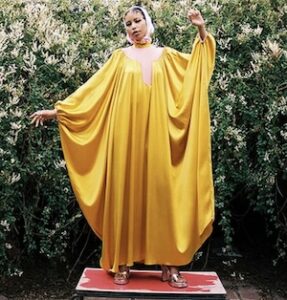Modern: Women in Abstract Expressionism
By Jo Phillips
Depending on who you ask, Abstract Expressionism can either be a German movement from the early 20th century or an American movement from the 1940s and 50s. The German movement was the first instance of abstraction in art, characterised by completely non-figural forms. The American movement showed emotions abstractly, involving a heavily expressive and personal manner of applying medium. A notable Abstract Expressionist, Jackson Pollock, is known for his method of laying a canvas out on a floor and throwing paint onto it.
 Jackson Pollock, Full Fathom Five, 1947
Jackson Pollock, Full Fathom Five, 1947
But what the two movements of Abstract Expressionism have in common is that the key figures of both movements are men. Wassily Kandinsky, a Russian painter who spent his career in Munich, is celebrated for having started the first Abstract Expressionist movement and is often noted as the first abstract artist. And the post-World War II movement is memorialised by the works of Pollock and his contemporary, Willem de Kooning. Yet there were women working in the same abstracted styles as these guys who may have beaten the men at their own game.
Hilma af Klint, a Swedish painter operating around the turn of the 20th century, had a clearly abstracted style. Quite remarkably, her abstract works started in 1906, four years before Kandinsky’s first abstract watercolour work. Between 1906 and 1915, Klint created her central body of work, entitled Paintings of the Temple.
 Hilma af Klint, Altarbild, 1915,
Hilma af Klint, Altarbild, 1915,

Hilma af Klint, Altarpiece No. 1, 1915,
As a teenager, Klint lost a sister and in turn developed an interest in spirituality and the occult. This fascination continued throughout Klint’s life and career and was the catalyst for her avant-garde work. During a séance in 1904, a spirit told Klint to create works to represent the immortal aspects of humanity. In her abstracted works that appeared soon after this experience, Klint felt spiritual forces guided her process. Interestingly, much of Kandinsky’s work was also influenced by spirituality.
Klint’s abstract work was done privately; she made a nice living for herself selling landscape and portrait paintings. A woman far ahead of her time, she probably realised that audiences of her time would not have been interested in abstracted works. While non-figural art is something people in modern society accept easily, in 1906 and even after Kandinsky began working abstractly, abstract art was heavily criticised and quite controversial.
 Wassily Kandinsky, Unititled (First Abstract Watercolor), 1910
Wassily Kandinsky, Unititled (First Abstract Watercolor), 1910
Today, we only know Klint for her abstract art and don’t seem to care too much for the conventional works that earned her fame during her time. The Serpentine Gallery is presenting an exhibition solely of Klint’s work, focusing on the Paintings for the Temple series and showing her as a pioneer of abstract art. The exhibition will run from early March through May.
In the realm of American Abstract Expressionism, Grace Hartigan fit in nicely with Pollock and de Kooning, with whom she was quite friendly while living in New York in the 1950s. She found inspiration from the movement’s use of harsh, noticeable brushwork and used the style to communicate her own themes. Her experimental Grand Street Brides of 1954 depicts the window of a bridal shop, commenting on the traditional role of women. Unlike Hartigan’s contemporary Abstract Expressionists, she incorporated recognizable everyday elements in this work.
 Grace Hartigan, Grand Street Brides, 1954
Grace Hartigan, Grand Street Brides, 1954
Different from Klint’s experience, Hartigan’s abstract works met great success and attention during her time in New York. Hartigan however left the centre of the American art world in 1960 and relocated to Baltimore and was able to truly explore her own individuality in her work. Though her works of this time incorporate geometric forms and some commercial imagery, the expressive impact of Abstract Expressionism continued to be noticeable in her work. This is especially evident in the 1965 Reisterstown Mall, which conceptually expresses the theme of chaos in modern society.
 Grace Hartigan, Reisterstown Mall, 1965
Grace Hartigan, Reisterstown Mall, 1965
Interestingly, Klint’s work had no direct influence by the Abstract Expressionists operating in Germany yet stylistically and thematically appeared to be quite similar, while Hartigan worked alongside the expressionists in New York and spent her career attempting to shed that influence and find her own unique style. Despite the polarised differences between the two women, they’re similar in that both artists acted in a modern way, using styles and themes ahead of their own times, working in movements that were dominated primarily by men.
Klint and Hartigan were not alone in female contribution to Abstract Expressionism. In June of this year, the Denver Art Museum will exhibit twelve lesser-known Abstract Expressionist artists in Women of Abstract Expressionism.





